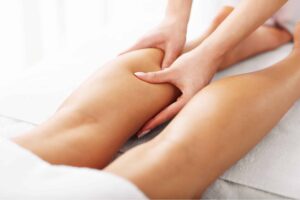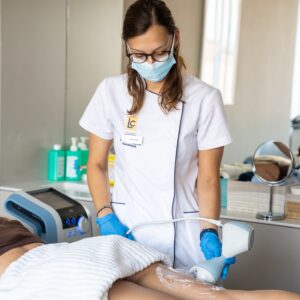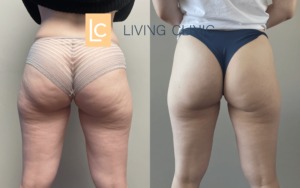What is fluid retention in the legs?
Fluid retention in the legs occurs when there is excessive fluid accumulation in that area of the body (including the thighs and areas below the knees).
What are the symptoms of fluid retention in the legs?
Symptoms of fluid retention in the legs may include:
- Swelling: Swelling is the most common symptom of fluid retention in the legs. Legs may appear swollen, heavy and tense, making it difficult to wear shoes and clothes;
- Pain or discomfort: Excessive swelling can cause pain or discomfort in the legs, making normal movement difficult;
- Stretched skin: The skin over the swollen area may appear tight and shiny due to the pressure of accumulated fluid;
- Sunken skin: When you lightly press the skin in the swollen area, it may form a temporary depression before bouncing back;
- Changes in skin color: In more serious cases, fluid retention in the legs can affect blood circulation, leading to a change in skin color, which may become paler or redder;
- Feeling hot: The swollen area may feel hotter to the touch due to increased blood flow and inflammation;
- Limited mobility: Excessive swelling can limit range of motion in the legs, making it difficult to walk or move comfortably;
- Worsening throughout the day: Swelling generally tends to worsen throughout the day, especially after prolonged periods of standing or sitting.
What are the causes of fluid retention in the legs?
Fluid retention in the legs can be caused by several factors, such as circulatory problems, physical inactivity, pregnancy, hormonal changes or underlying medical conditions (such as heart failure, kidney or liver problems, among others).
Why does fluid retention affect women more?
Fluid retention is most often seen in women due to hormonal factors, such as fluctuations throughout the menstrual cycle and during pregnancy. Changes in estrogen and progesterone levels can influence fluid regulation and blood vessel permeability. Additionally, pressure exerted by the uterus during pregnancy and aging can contribute to fluid retention, along with genetic variations and lifestyle factors.
Although this condition can also affect men, women’s hormonal and physiological particularities tend to make them more susceptible to this phenomenon.
In the particular case of pregnancy, there are many changes in a woman’s body that can cause fluid retention. Below are some examples:
- Hormonal changes: During pregnancy, there is an increase in the production of hormones such as estrogen and progesterone. These hormones can cause changes in the permeability of blood vessels and affect the regulation of fluid balance, contributing to fluid retention.
- Pressure on blood vessels: The growing uterus puts pressure on the main veins in the pelvic and abdominal region, making it difficult for blood to return from the lower extremities to the heart. This can result in increased pressure in the leg veins, leading to fluid accumulation in the tissues.
- Changes in circulation: Pregnancy can cause changes in blood circulation, resulting in slower blood flow in the legs. This can make it difficult to transport fluids efficiently and contribute to swelling.
- Increased blood volume: During pregnancy, the body produces more blood to meet the needs of the growing fetus. This increase in blood volume can overload the circulatory system, contributing to fluid retention.
- Uterine pressure on lymphatic vessels: As the uterus grows, it can put pressure on the lymphatic vessels, which are responsible for draining excess fluids from tissues. This can lead to decreased lymphatic drainage and contribute to swelling;
- Resting position and limited physical activity: During pregnancy, many women spend more time in a resting position or sitting due to discomfort or fatigue. This can affect blood flow and circulation, contributing to fluid retention.
How to prevent fluid retention in the legs?
Although it is difficult to completely prevent fluid retention in the legs, there are steps you can take to help minimize the risk and control symptoms. Here are some tips that might be helpful:
- Stay hydrated: Drinking enough water throughout the day can help maintain fluid balance in the body and facilitate the elimination of toxins;
- Reduce your sodium intake: Sodium can contribute to fluid retention. Try to limit your intake of processed foods, fast food and foods high in salt;
- Maintain a balanced diet: Consume foods rich in potassium, such as bananas, oranges, avocados and spinach, as potassium helps regulate potassium levels.
- Stay active: Practicing physical activity regularly can help improve blood and lymphatic circulation, reducing the risk of fluid retention and, consequently, swollen legs;
- Elevate your legs: Elevating your legs for a few minutes several times a day can help reduce leg swelling;
- Wear comfortable clothing: Tight clothing can impede blood flow and contribute to fluid retention. Choose comfortable, non-restrictive clothing;
- Avoid standing or sitting for a long time: Move regularly, especially if you have a job that involves sitting or standing for long periods;
- Massage your legs: Gentle leg massage can help stimulate circulation and lymphatic drainage;
- Maintain a healthy weight: Maintaining a healthy weight can reduce pressure on your blood vessels and help prevent fluid retention.
What are the recommended treatments for fluid retention in the legs?
Living Clinic offers effective treatments for fluid retention, including:
Lymphatic drainage massage
Lymphatic drainage is a therapeutic technique that stimulates the lymphatic system, helping to eliminate toxins and properly transport fluids from the body. This gentle, rhythmic massage promotes lymphatic circulation and helps reduce swelling, providing immediate relief.

EMTone
EMTone is a revolutionary treatment developed by BTL Aesthetics that combines advanced radiofrequency and shock wave technologies to improve blood circulation, stimulate metabolism and reduce fluid retention. This non-invasive, painless approach delivers visible results, helping to tone the skin and reduce puffiness.

Liquid Retention in Legs and Cellulite: Before and After

Schedule a free assessment to hear our professionals’ recommendations for your particular case and clarify all your doubts.
We are at Av. da Boavista, in Porto!



